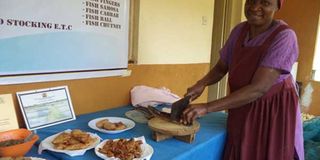What my fish gives me: Pizza, samosas and kebabs

Zinath Deen makes different products from fish in her farm in Tigoi, Vihiga County. PHOTO | EVERLINE OKEWO |
What you need to know:
- Value of the fish triples when used in certain foods.
- Fish has numerous health benefits.
Zinath Deen is dressed in a red apron, a purple dress and her head covered in a woollen cap.
On a table next to her are various food items that affirm her culinary skills. They include samosas, kebabs and pizza.
There is also a bowl of wheat flour, margarine and freshly harvested fish.
Deen makes the samosas, kebabs and pizza from tilapia and catfish that she rears in seven ponds in Tigoi, Vihiga County.
“I don’t sell all my fish, I use some to make various products,” she tells Seeds of Gold at her Tigoi Fish Farm.
Each pond has about 800 tilapia and catfish. Next to the fish ponds are nursery tanks that hosts more than 100,000 fingerlings which she breeds and sells to the County Government of Vihiga at Sh8 each for tilapia and Sh10 for catfish. The county distributes them to fish farmers.
After harvesting the fish, she takes them to a processing unit a few metres from the ponds where she fillets them.
To make pizza, she starts by deep frying the filleted fish for about 10 minutes.
She then prepares pastry using wheat flour, adding in it margarine, fermented milk or baking powder, salt and sugar.
She, thereafter, covers it with a piece of cloth and leaves it to dry.
“The pastry should be thicker than that of making chapati to enable it host various food items that will be placed on it,” says Deen.
She then puts tomato paste on the pastry and adds a vegetable (preferably spinach), onions, carrots and coriander. The paste helps to stick the ingredients on the pastry.
“I then put the fried fish cubes on the pastry and add cheese on top, and later apply margarine on the tray on which I put the pastry and bake it in an oven for between 10 and 15 minutes for the pizza to be ready.”
Another product she makes using fried filleted tilapia or catfish is samosas.
Once again, she makes pastry using wheat flour, salt, milk and water, and cuts it into small triangular pieces.
“I, then, heat the pieces in a cooking pan under low heat and allow them to cool. During this stage, I add a little maize flour mixed with water to a texture of porridge.”
She then folds in the pastry the fried fish and deep fries it for a few minutes until it is ready.
Similarly, she starts making fish kebabs by boiling the fish fillets in salty water for 10 minutes and then she fries.
Afterwards, she boils Irish potatoes and mashes them, later mixing with filleted fish and various spices. She after that makes pastry, puts in the mixture of fish and potatoes and deep fries until it turns to golden brown.
The kebab is further dipped into an egg and fried for three seconds.
VALUE TRIPLES
A piece of mature tilapia weighing about 500g goes for Sh500 in the retail market.
“The value of the same fish triples when used to make pizza or kebab,” says Deen who started fish farming in 2010.
“I use a single fish to make five pieces of pizza that I sell at Sh400 each, earning more.”
The farmer sells a piece of fish kebab at between Sh50 and Sh100 while samosa retails at Sh30.
“I sell an average of 20 kebabs, 15 pizzas and 100 samosas per day,” says Deen, who sells the products mainly to residents.
In a month, Deen makes a tidy sum from the fish products.
“My late husband was Asian. He is the one who taught me how to make the products. He was a very good cook.”
The farmer was motivated to venture into value addition to promote fish eating and earn more cash.
“Many people, particularly, those who do not come from lakeside or ocean do not eat fish but when you add value, this expands consumption,” says Deen.
She works closely with the Ministry of Agriculture officials and various farmers’ organisations.
The partnership has seen her attend various farmers’ events across the country and in Israel and Germany.
HEALTH BENEFITS
George Wanjala, a research scientist at the Food Technology Division, Kenya Industrial Research and Development Institute, says that fish has numerous health benefits.
“It is a good source of quality protein as compared to meat. It is also a good source of minerals and fats, especially the Omega-3 fatty acids which are heart friendly,” he notes.
“Eating fish can help reduce the risk of heart diseases and improve chances of survival of a heart patient. Fish does this by lowering in the blood levels of fats called triglycerides associated with heart disease.”
He adds that fish helps in brain development in children and is a good source of Vitamin A, B, D, zinc and calcium.
“Adding value to fish is the best way to improve consumption and earnings for the farmer. Some people cannot eat cooked fish but will like it in kebabs and pizzas.”





